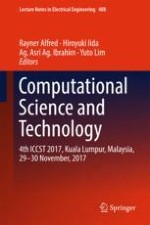2018 | Buch
Computational Science and Technology
4th ICCST 2017, Kuala Lumpur, Malaysia, 29–30 November, 2017
herausgegeben von: Prof. Dr. Rayner Alfred, Prof. Hiroyuki Iida, Prof. Dr. Ag. Asri Ag. Ibrahim, Prof. Dr. Yuto Lim
Verlag: Springer Singapore
Buchreihe : Lecture Notes in Electrical Engineering
